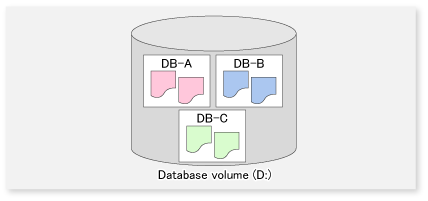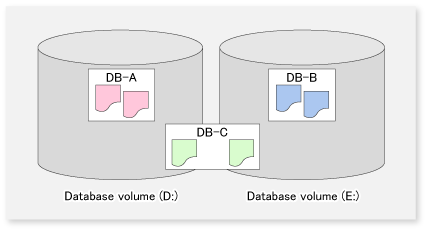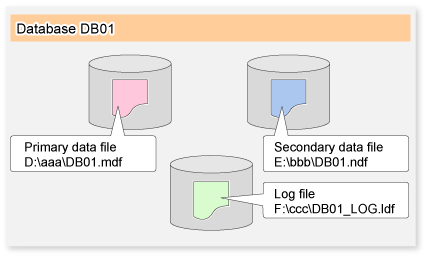To configure the backup of a database, refer to "Designing a Backup and Restore Strategy" in the "SQL Server Books Online".
In addition, observe the following limitations on the construction of database files.
AdvancedCopy Manager does not support a database constructed in raw partitions. Databases must be constructed within the logical boundaries of a file system.
AdvancedCopy Manager performs copy in units of volume (i.e., in units of partitions). Therefore, do not store any files other than target database files in the volumes on which the database files are placed.
Note
If a file that is not a part of the database files is placed in a volume to be backed up, not only the data of the file but also the entire file system might be corrupted.
In particular, do not place any database file on the system drive or on the volume that stores the executable files and management files of SQL Server and AdvancedCopy Manager.
Point
The following scenarios are not recommended unless these databases are under the control of the same instance:
Files from more than one single database constructed on any one single volume, and/or More than one database constructed on any one single volume, and/or
Files intrinsically related to different databases or instances spread across the same array of multiple volumes.
Figure 10.5 N databases on one volume

Figure 10.6 N databases on M volumes

If you perform the backup of the database with such a configuration, specify all the databases which exist on the volumes. After SQL Server secures the data consistency by freezing all the specified databases, AdvancedCopy Manager executes the copy processing to all the volumes where the files are placed. If the backup is performed without specifying all the databases, the database backup cannot be created correctly, because the file systems of the backup volumes might be damaged.
The abovementioned database configuration is found in a system with insufficient drive letters or a system where many small-scale databases exist, and has the following problems in respect of backup:
When two or more databases are backed up at the same time, all the specified databases are frozen by SQL Server until processing is completed. If the database is frozen for an extended period, there is a possibility that the backup cannot be completed correctly. Design the databases so that the number of databases to be backed up is kept to a minimum.
If you want to restore a specific database, you cannot use the Advanced Copy for file restoration processing. In this case, only the database files to be restored must be restored by the means of the COPY command or FTP, etc. The Advanced Copy can be used only for file restoration when all the databases are restored.
Point
As shown in the figure below, you can distribute database files over multiple volumes. AdvancedCopy Manager performs processing on all the volumes on which database files are placed.
Figure 10.7 Distributed placement of database files

If a full text catalogue is used under SQL Server 2005 or later, it can be created on any of the database volumes. This includes the full text catalogue in database backup and restore operations.
If the full text catalogue is created on a non-database volume, the full text catalogue will not be backed up and will need to be reconstructed after restore is executed.
Determine the servers that are required to perform backup.
The following servers are used to perform backup:
Management Server
Multiple Managed Servers are unified, and are operated centrally. The manager function of AdvancedCopy Manager should be installed. A Management Server can also be used as a Managed Server.
Managed Server (a Business Server)
SQL Server is run on this server. The agent function of AdvancedCopy Manager should be installed on this server. Backup and restore of databases are performed on this server.
Managed Server (a Backup server: only if the replication management function is used)
The Managed Server typically performs the role of a backup server, with the agent function of AdvancedCopy Manager installed on this server. The volumes (i.e., backup volumes) which become the backup destination of database volumes are connected to this server. The operation using a backup server can be executed only if the replication management function is employed and so cannot be executed if the backup management function is used.
Determine the databases to be backed up and the volumes (i.e., the database volumes) where their database files are located.
All the database volumes must be placed on the ETERNUS Disk storage system.
Determine the backup method.
One of the following two methods can be selected as a backup method.
Snapshot type backup
This is a backup method using the OPC function of the ETERNUS Disk storage system. The backup is obtained by starting OPC.
Point
For information on the differential snapshot high-speed backup, refer to "Chapter 6 Backup Operation using QuickOPC Function".
Synchronous type backup
This is a backup method using the EC/REC functions of the ETERNUS Disk storage systems The backup is obtained by stopping (in the case of using the backup management function) or suspending (in the case of using the replication management function) EC/REC in the equivalency maintenance state.
Point
When the backup management function is used, a backup is created by stopping or suspending EC/REC under the equivalency maintenance status. When swstbackup_sqlsvr (SQL Server backup execution command) is executed with -suspend option specified, the Suspend/Resume function suspends the equivalency maintenance status and executes the backup.
For information on the Suspend/Resume function, refer to "Chapter 5 Backup Operation using Suspend/Resume Function".
The volumes which become the backup destination of database volumes are called backup volumes.
All the backup volumes must be placed on the ETERNUS Disk storage system.